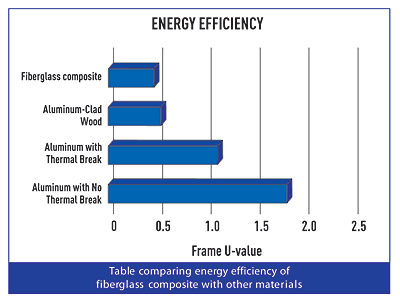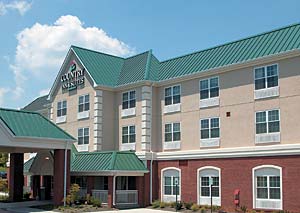Fiberglass Fenestration: A Durable, Sustainable, and Economic Alternative for Windows and Doors
|
"For a large-scale multi-family development in the Northeast, where wide temperature swings are the norm, important window selection criteria includes limiting heat load to conserve energy in the summer, maximizing daylighting, and minimizing glare," says Jeremy Edmunds, Assoc. AIA, P.E., LEED-AP, sustainability advisor, Cherokee Northeast, New York, New York.
Fiberglass composite also compares well to vinyl and aluminum in product life cycle, aesthetics, and performance.
- Life cycle: Fiberglass composite is long lasting, and is a strong, durable fenestration material.
- Appearance: Various finishes are available to achieve different looks. Options include a powder-coat paint finish, with a textured substrate for a wood look, to conventional pultrusion, whether wet-painted or acrylic-capped, which tends to look more like plastic.
- Performance: Based on certification from stringent industry testing standards, fiberglass composite fenestration has a superior performance in any environment. When assessing the aesthetic appeal of windows, design professionals and building owners also consider the life cycle costs and benefits of material selection. As a durable, economical, high performance material with a long life cycle, fiberglass has several advantages, whether for restorations or replacement windows. Vinyl windows look plastic, while fiberglass exhibits a smooth, consistent, aesthetic finish.
"The problem with many early fiberglass windows is that they didn't match the sturdy appearance of solid wood windows, the industry standard for most applications. However, the latest generation of fiberglass composite windows address this important aesthetic issue. As a result, they have become a viable alternative, particularly when extreme weather environments are at play: they don't rust and they are energy efficient," says Anthony S. Barnes, AIA, principal, Barnes Vanze Architects, Inc., Washington D.C.
|
CASE STUDIES
Fiberglass composite fenestration products are suitable for all building types, including hotels, multi-family housing, university buildings and dormitories. The following projects illustrate how fiberglass composite windows have been successfully installed in various applications.
Tennessee Hotel: A Win-Win Situation
At the Country Inn & Suites, in Knoxville, Tennessee, single-hung, fixed fiberglass windows were selected, primarily for cost, but also due to long-range maintenance issues. According to Lanny Cope, AIA, president, Cope Associates, Inc., Knoxville, Tennessee, fiberglass composite was selected over aluminum windows because aluminum can scratch during installation, while fiberglass doesn't.
"Both perform relatively equal, but for us, the first cost for fiberglass windows was lower than for aluminum. The owner was so happy with the fiberglass composite windows, he wants to use them again on another hotel project. The builder liked them because of the ease of installation, and they didn't have to be as careful regarding scratching. For the architect, it's a win-win situation, and for the owner, the product does the job for less cost than an alternative selection," Cope says.











